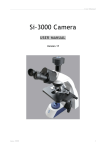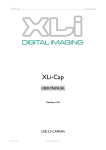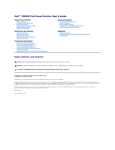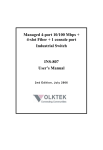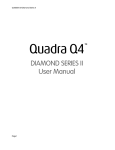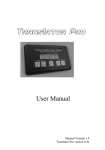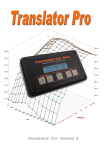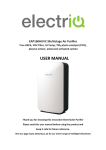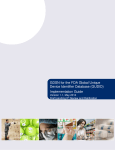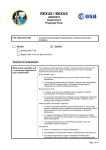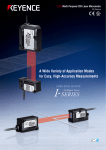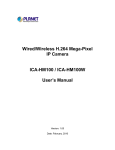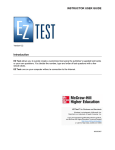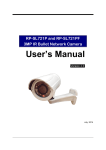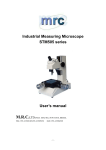Download User Manual
Transcript
User Manual XLICap USER MANUAL Version 12.0 USB 2.0 CAMERA March 2006 XL Imaging Ltd. 1 User Manual Contents Trademark and copyright information Welcome .......................................................................................................3 Warnings and Precautions System Requirements .............................................................................4 .....................................................................................5 Package Contents ...........................................................................................6 Installing the Software ....................................................................................7 Using the Capture Software Trouble Shooting .........................................................................13 .........................................................................................28 Technical Data ..............................................................................................30 Uninstalling Camera and Software Warranty March 2006 ...............................................................32 .....................................................................................................33 License Agreement Contact Info ............................................................3 .......................................................................................34 .................................................................................................35 XL Imaging Ltd. 2 User Manual Trademark and copyright information © Copyright 2004,2005,2006 XL Imaging Ltd All rights are reserved. No part of this document may be photocopied, reproduced, or translated to another language without the prior written consent of XL Imaging Ltd The information contained in this document is subject to change without notice. XL Imaging Ltd shall not be liable for errors contained herein or for consequential damages in connection with the furnishing, performance, or use of this material. Microsoft® and Windows® are U.S. registered trademarks of Microsoft Corporation. XLICap is © Copyright 2004,2005,2006 XL Imaging Ltd., UK. Welcome Thank you for buying our high resolution USB2.0 camera. We suggest you spend a few minutes carefully reading this user manual before installing and using your camera. Please keep this user manual in a safe place for future reference. March 2006 XL Imaging Ltd. 3 User Manual Warnings and Precautions Precautions when using your camera: Keep camera away from the following: · High temperatures and excessive humidity · Direct sunlight or other heat sources · Dust · Extreme vibration If the imaging sensor becomes dirty, first try blowing dust particles from it. Next use a lint free cloth or proper lens cleaning cloth to wipe the sensor gently. Only use approved lens cleaning fluids. Never touch the sensor with your fingers! Do not allow the camera to come into contact with water or any other liquid. If water or a foreign substance should get in the camera, unplug the camera immediately and do not attempt to plug in until after a long period of time to allow for drying. This does not necessarily mean it will work again! Do not open the camera case or attempt your own repairs. Internal components may create risk of electrical shock or fire. There are no user serviceable components inside. Additionally, the camera was assembled and cleaned in a strictly dust-free environment. Any attempt to open the case will certainly contaminate the sensor, degrade the image and will void the warranty. Clean the outside of the camera by wiping with a clean, dry cloth. Never use harsh or abrasive cleaners or organic solvents on the camera or any of its parts. If you notice smoke or a strange smell coming from the camera, immediately unplug the camera and consult an authorised dealer. March 2006 XL Imaging Ltd. 4 User Manual System Requirements • PC running either Windows ® 2000 or XP • DirectX 9.0 or later installed • 1.8GHz minimum processor • USB 2.0 Port • CD-ROM drive • 64 MB RAM Performance is dependent on your PC's graphics card. USB 2.0 is only supported on Windows ® XP and 2000. Do not try to use any other Microsoft ® operating system. Windows 2000 must have Service Pack 4 (or later) installed and XP Pro must have Service Pack 1 (or later) installed in order for the camera to function correctly. The installation program supplied on the XLI Capture CD ROM will automatically check to see if you meet the above system requirements and prompt you to install any missing components. To check if you have USB2.0 installed on your computer go to: Start > Settings > Control Panel > System… or 'right-click' on “My Computer” and select “properties” from the context menu... Click on the “Hardware” tab and then onto the button “Device Manager”; Within Universal Serial Bus controllers (USB controllers) you will see a list of USB devices installed on your machine. In this example the red arrow is indicating the USB2.0 device. USB2.0 controllers may be labelled as USB2.0 controllers, however they may also be labelled as “Enhanced” or “Standard Enhanced” controllers. The so-called “Standard” or “Standard Universal” controllers are for the slower USB1.x system. March 2006 XL Imaging Ltd. 5 User Manual Package Contents 1 x Camera 1 x USB 2.0 Cable 1 x USB 2.0 Cable 1 x CD-ROM If there are any parts missing from your package, please contact your dealer. On the underside of the Camera is a label containing the Serial number. The first digit of this serial number denotes whether the camera is a 1.3mega-pixel, 2 mega-pixel or 3 mega-pixel, simply by starting with a “1”, “2” or a “3”. March 2006 XL Imaging Ltd. 6 User Manual Installing the Software Insert the XLI CD-ROM into your drive. Do not connect your camera at this point. The installation program should auto-run and display the following Set-up window. If the program does not auto-run then you need to run the setup.exe from the CD-ROM. To do this, go to “My Computer” and right-click on the CD Drive and choose “Open” or “Explore”: this will show you the contents of the CD-ROM where you can double click the “setup.exe” icon in order to run it. Read the Welcome screen carefully all the way to the bottom and when ready press the “Continue” button. If you do not have the correct Operating System specified you will get the following error message: You will not be able to install XLI software. March 2006 XL Imaging Ltd. 7 User Manual If you do not have the correct Service Pack, you will now be prompted to install one: 2000 Service Pack 4 XP Service Pack 1a Click “Yes” to install the relevant Service Pack and follow the on-screen instructions. You may be asked to restart your PC. Do this and leave the CD ROM in the drive. After your PC restarts, the Set-up window should open again (if it does not open please run “setup.exe” on the CD ROM by hand as described above). Press the “Continue” button. If you do not have the correct version of DirectX installed you will see the following message prompting you to install the latest version: Click “Yes” to install DirectX and follow the on-screen instructions. You may be asked to restart your PC again. Do this and leave the CD ROM in the drive. Once your PC restarts again the Set-up window should open again (if it does not open please run “setup.exe” on the CD-ROM by hand as described above). Press the “Continue” button. March 2006 XL Imaging Ltd. 8 User Manual An installation progress report will appear in the window. This window will automatically close after about ten seconds. Connect your camera to the USB 2.0 port on your PC. Windows will detect the new hardware and display the “Found New Hardware Wizard”. The first window that appears in XP SP2 asks whether you want to use Windows Update on the Internet to find drivers for this new hardware (providing you have not previously checked the “Yes, now and every time I connect a device”) The option “No, not this time” should be chosen, otherwise “Windows Update” will spend a while searching for a non-existent driver for the camera on Internet and will complain that it cannot find one. March 2006 XL Imaging Ltd. 9 User Manual Press the “Next” button. Select the “Install from a list or specific location (Advanced)” button and click “Next”. Select the radio button “Search for the best driver in these locations”. Tick the “Search Removable Media” checkbox, untick the “Include this location in the search” checkbox and click the “Next” button. You will see the following warning: March 2006 XL Imaging Ltd. 10 User Manual The actual driver name given in this screen (and on some of the screens thereafter) will have the “XXX” replaced with “1.3M”,“2M” or “3M” depending on which camera you are installing. Press “Continue Anyway” when this window shows. When Windows has finished installing the camera driver, click finish. It is unlikely, but you might get an error report on this final screen if the driver found that it couldn’t run. Error code 10 is where the camera driver started up but failed to find the camera hardware. Please contact XL Imaging’s customer support if this happens. Error code 37 is where the driver detected a Pentium II (or earlier) processor type. We’re sorry, but the camera is a high-performance, high-bandwidth device and processors older than the Pentium III just won’t work with it. Assuming you see the screen above, installation is now complete for this particular March 2006 XL Imaging Ltd. 11 User Manual camera/port. If you have another camera or intend to use an an additional port, plug the camera cable into your chosen port in order to install additional drivers via the “Found New Hardware Wizard”. Once the installation is complete, you should see a shortcut on your desktop called XLICap with the XLI Logo. March 2006 XL Imaging Ltd. 12 User Manual Using the Capture Software To open the XLICap program double click the icon on your desktop. The main window will be opened and the real-time image from your camera will be displayed. Toolbar Above the image display you will see the Main Toolbar: Select: When this button is depressed, XLICap is in "Select Mode". In this mode a click on a drawn line or measurement will select it. (See “Draw” and “Measure” modes below). The selected item will be highlighted in a dotted rectangle. Use the delete key to remove any selected item. Zoom: There are two settings: “Fit to Window” and “Actual Size”. Once the button is depressed, each new click will toggle through these settings. Fit to Window – Scales the image to fit whatever size window is being used, while maintaining the camera sensor aspect ratio. Actual Size – Displays pixels one-to-one on the screen. In either of the above settings of Zoom mode, the mouse cursor becomes a “pan” tool. Click on the viewing window (holding the mouse button down) and drag the mouse so as to pan the image around the window. March 2006 XL Imaging Ltd. 13 User Manual Draw: When this button is depressed, XLICap is in "Draw Mode". You can draw lines in this mode by simply holding down the left mouse button and dragging. This button has its own right click context menu. From this menu you can choose a pencil colour from the list, or select “Erase All” to erase the complete drawing. Note: “Erase All” will also erase any measurements on the image. Measure: When this button is depressed, XLICap is in "Measure Mode". Hold down the left mouse button over a section of the image and drag to somewhere else in order to take a measurement. The Measure button has its own context menu. Selecting “Edit” from this menu brings up the “Edit Scale” dialog box. From here we can add a new scale, edit an existing scale, or delete an exiting scale. Using Measure Mode - Let's say we are using a microscope in a 10x magnification mode and prefer our measurements displayed in micrometres and millimetres, and not pixels. We focus on a 1000 micrometre reticule slide, click the measure button to switch to "Measure mode" and measure the scale on the slide. The line drawn will have a length in pixels as its value. Right click on the Measure button and select “Edit” from the context menu to bring up the “Edit Scale” dialog box. The measure scale will be checked as “none”. Click the "Add" button to create a new scale. This will have the default name "New Scale". Let's change this name to the more meaningful "10x". Once done, click "OK" followed by "Close". To try out our new scale, right click on the measure button and choose the "10x" scale from the context menu. Any future measurements will be displayed in micrometres and millimetres. These values will be accurate for the 10x mag setting of the microscope. We can add additional scales to the context menu to support more magnification modes, by repeating the procedure above. Note: A change of magnification without selecting a new scale makes any measurements meaningless. Area Measure : When this button is depressed, XLICap is in “Polygon Area Measure Mode”. Click the left mouse button on a corner of an area to be measured, then proceed around the shape, clicking on every point where the perimeter changes direction. Finish the polygon with another click on the Area Measure button or hit the ‘Esc’ key on the keyboard. The last point March 2006 XL Imaging Ltd. 14 User Manual on the polygon that you defined will be joined to the first, the polygon will be filled in on the screen and its area will be displayed. As with linear measurements above, the system has to be calibrated for this value to have any meaning. Please do not try drawing shapes that involve the perimeter crossing itself (as with a figure-8 or bowtie shape). The results will not be useful. Save : When the “Save” button is pressed, whatever image is currently being displayed will be captured as a still image. The default location is the Desktop, the default format is JPEG and the default file name is “image”. For every subsequent press of the “save” button, a new image will be captured with an incremental number suffixed. [e.g. “image0.jpg” followed by “image1.jpg” then image2.jpg” and so on.] Save As : When the “Save As” button is pressed, the currently-displayed image is captured and the standard “save as” dialog box opens. Here you can specify a file name, location and file type of the image to be saved. Available file types are “JPEG”, “BMP” and “TIFF”. Once this has been done once, this file name, location and file type now become the default for the “save” button. Every press of the “save” button now saves the image to the new location, with the new name and format with an incremental suffix number. [e.g. Save as “mypicture.bmp”, then next time “save” is pressed a new image will be captured called “mypicture0.bmp” and then “mypicture1.bmp”, “mypicture2.bmp” and so on until a new file name, location and/or file type is specified.] Copy: When the “Copy” button is pressed, the current displayed image will be captured and copied to the clipboard. This allows you to paste the image into another program. Email: When the “Email” button is pressed, whatever the current display is showing will be captured and saved as if the “save” button had been pressed. It will also be attached to a “new email” using the default email client of the PC. You will be able to edit this email before sending it. Freeze: Pressing this button will instantly freeze-frame the image, and the green “traffic lights” icon will change to a red light icon to indicate that the image is frozen. When the image is frozen, the still image can be saved, emailed and copied using the appropriate buttons - just as above. Press the “Freeze” button again to resume live video. The “traffic lights” icon will be green when the video is live. Colour: When this button is pressed the image will change to monochrome mode (black and white) and the button's icon appears as grey stripes. Press the button again to return to full colour March 2006 XL Imaging Ltd. 15 User Manual mode, and the button will appear as coloured stripes. This button is disabled if you have a monochrome camera. Resolution: This button toggles between the high-resolution and low-resolution modes of the device. High-resolution is indicated by a fine grid of squares and low-resolution mode is represented by a coarse grid. To check what resolution you are running in you can hover the mouse over the “resolution” button and a tool tip will appear, indicating the mode in which the device is running. Rotate: This button will rotate the image through 180 degrees. Note: this is achieved by applying a Flip and Mirror. White Balance Control: If the button is not depressed, i.e. Grey, then White Balance is in a locked state. Pressing the button so it is depressed (background changes colour) will enable Automatic White Balance and the image will begin balancing. This button can either be left depressed in automatic mode, or pressed again to 'lock' the current white balance settings. This function is disabled for monochrome cameras. Negate: This button may be used to toggle between negative and positive images. Camera Controls: This button opens the “Camera Controls” dialog box as described later. Annotation: When “Annotation” is selected, the current annotation text is displayed at the bottom left of the image window. The time and date will be displayed to the bottom right when the “Date &Time” checkbox is enabled. The format of the annotation can be edited by selecting “Edit Annotation” from either the edit menu, or the context menu, or by pressing “Ctrl + A”. This will display the “Edit Annotation” dialog box. March 2006 XL Imaging Ltd. 16 User Manual If “Save Annotation” is selected, the formatting and Title of the annotation will be retained next time the program is started ONLY if the settings have been saved either by selecting “save Settings” from the File menu, or context menu, or by having “Save on exit” checked. If the settings are not saved, the annotation will reset to the text “Annotation” next time the program is run. Record: When this button is pressed, the current live image will begin to be recorded. Whilst recording, all other functions are inactive. The recording will be made in whatever resolution setting is currently selected. Time Elapsed: Once “Record” has been pressed and live video is being recorded, the time elapsed will be displayed here. Maximum time allowed per recording is 20 seconds. Stop: To stop the video being recorded press this button. Once stopped, the “Save Movie As” dialog box appears. Here you can give the video a name and choose where to save it. Default location is the Desktop. AVI is the only format available. Luminance / Exposure Control: This slider bar allows adjustment manual adjustment of either Luminance or Exposure, dependant on the Automatic Exposure Control (AEC) mode. [ There is an “AEC” button on the Toolbar to the right of this slider which offers a means to enable or disable AEC mode (it can also be done from the “Camera Controls” dialog). ] When AEC is enabled, the slider will become a “Luminance Control”. When AEC is disabled, the slider becomes an “Exposure Control”. N.B.: When the banding filter is on, the slider moves in steps depending on mains frequency (see the entry in the “Camera Controls” section for details). Automatic Exposure Control: When the “AEC” button shows red, then the automatic exposure mode is disabled, freezing the camera's current exposure-time, and the slider to the left allows manual setting of exposure-time should it need to be changed. When the button is green, AEC is enabled and the slider allows the user to select the desired image auto exposure-target. Automatic Luminance Control: March 2006 XL Imaging Ltd. 17 User Manual When the “ALC” button shows red, then the automatic luminance control is disabled and if AEC or AEC are enabled then their tactics are to try and balance the picture for an average mid-grey. If ALC shows green, then it is enabled, and the AGC/AEC tactic is to try and get the brightest part of the picture to be peak white in the image. Usually, it is best to use ALC when doing things like imaging paper documents, and to use the average mid-grey system for more “natural” scenes. It is worth experimenting with this. Flat Field Compensation: When this button is red, flat field is off; when green, flat field compensation is on. Note: A change of resolution or rotate of an image etc., will cause the flat field compensation to be disabled and the icon will turn red. Flat field is performed on a pixel by pixel basis in software. Flat field may also be selected from the “Camera Controls” dialog box. More information can be found in the “Camera Controls” section of this manual. Help: This button opens the “About” and “Quick Help” screen, showing release information and shortcut keys for various features. March 2006 XL Imaging Ltd. 18 User Manual Main Menu Assuming that it is enabled, a Menu bar will appear above the Toolbar. To enable the main menu when it is hidden, right click on the image and check “Show Menu” from the context menu. The main menu has the following options: File: Save – same as the “Save” button on the Toolbar. Save As – same as the “Save As” button on the Toolbar. Send as Email – same as the “Send as Email” button on the Toolbar. Default Settings – By selecting this, all settings will be returned to their master defaults as seen when the camera was supplied. Restore Settings – selecting this will return all settings to the last saved settings. Save Settings – saves all the current settings. Next time the program is started, all the settings will be as they were when this button was pressed. Exit - Click on “Exit” to close the program. Note: Always “Exit” the program before unplugging the camera; system crash may result otherwise. Edit: Copy – same as the “copy” button on the Toolbar. Edit Annotation.. - This opens a dialog box allowing the annotation to be edited. Annotation is discussed in the “Context Menu” section below. View: Resolutions – Selecting this opens a sub-menu showing the available resolutions for the current camera. The current resolution is indicated by the check. Colour – switch between colour and monochrome mode. Colour mode is active when checked. Full Screen – Changes to full screen mode. This can also be achieved by pressing “Alt + Enter” Freeze – same as the “Freeze” button on the Toolbar. When the image has been frozen, this option will be checked. March 2006 XL Imaging Ltd. 19 User Manual Flip Image – Flips the image from top to bottom. Mirror Image – Mirrors the image from side to side. (Checking both “flip” and “mirror” results in a 180 degree rotation. This is what the “rotate” button on the Toolbar does) Reticule – A sub-menu is displayed with "Load", "Clear" and "Colour". This allows us to load a reticule from a list, clear it, or change its colour. Mode: Select Item – This switches to selection mode. The current state is indicated by the dot mark. Zoom – The two settings described for the Toolbar can be accessed from here. The current setting is indicated by a dot mark in the “Zoom” sub menu. Draw On Image – This switches to draw mode. The dot mark in the sub menu indicates the current state. Measure – This switches to measure mode. The current state is indicated by the dot mark in the sub menu Measure Area – This switches to measure-area mode, described under the Toolbar options earlier. Options: Camera Controls – This will open the “Camera Controls” dialog box where you can control properties of the display. This is discussed in more detail later. Show Menu – Display or hide the main menu bar. Show Toolbar – Display or hide the Toolbar. Button Saves Image – This option is only available on cameras with buttons. If it is ticked, then if the button is pressed and the image is live, then the image will be saved to disk using the same rules as if the “Save” button on the toolbar had been pressed. Button Freezes Image – This option is only available on cameras with buttons. If it is ticked, then when the button is pressed, the image will be toggled from frozen to live. If “Button saves Image” is also ticked, the image will only be saved on each transition from frozen to live. Show Annotation – when checked, annotation will be displayed on the image. Annotation is discussed later. March 2006 XL Imaging Ltd. 20 User Manual Save on Exit – when this is checked, all settings will be saved and retained for next time when the program is closed. Devices: This menu lists all compatible devices that are currently available to be viewed using the software. The device currently in use will be indicated. To switch between devices, simply click the one you wish to view. Help: This will open up the “About / Quick Help” dialog box, as does the “Help” button on the Toolbar. March 2006 XL Imaging Ltd. 21 User Manual Context Menu At any time (in full screen mode or not), you can right-click on the display area to call up the context menu. All the menu items here do the same as the corresponding items on the Toolbar, button context menus and Main Menu. The “Button Saves Image” and “Button Freezes Image” options will be greyed-out if the camera doesn’t have a button.. Show Menu – When checked, this enables the main menu, which by default is not displayed. To toggle full screen mode you can always press Alt+Enter. To exit full screen mode, either right click and deselect “Full Screen” from the context menu or press Alt+Enter. March 2006 XL Imaging Ltd. 22 User Manual “Camera Controls” dialog box Colour Balance - When “White Balance” is set to “manual” the “Red Gain” and “Blue Gain” sliders are active and one can manually adjust them or type values into their associated entryboxes. When set to “Auto”, the colour balance is continually updating depending what the camera is looking at. The sliders are inactive in this mode. This whole section is greyed-out and inoperative if the camera is a monochrome type. Sensitivity – The camera's gain can be set manually by dragging the relevant slider, or AGC (automatic gain control) can be activated by checking the “AGC” box. If AGC is active then the manual slider is disabled, but can be monitored sliding in real-time as the camera selfadjusts the image. The camera's exposure-time can be set manually by dragging the relevant slider, or AEC (automatic exposure control) can be activated by checking the “AEC” box. If AEC is active then the manual slider is disabled, but can be monitored sliding in real-time as the camera self-adjusts the image. The current exposure-time (in milliseconds) is shown to the right of the luminance slider. Luminance – If the “Peak” box (to the right) isn’t ticked, then the desired average luminance target for the AGC/AEC system can be set by dragging the “luminance” slider to the desired March 2006 XL Imaging Ltd. 23 User Manual position. The actual average luminance is shown as a background blue bar on the “luminance” slider. If “Peak” is ticked, the slider is disabled and the AGC/AEC system tries to set it automatically. Saturation – this slider does the obvious thing, but is inactive if the camera is in monochrome mode. The “mono” check-box switches the camera to and from monochrome mode just as do the similar buttons and options on the menus and Toolbar. The saturation control is disabled if the camera is monochrome. Contrast – always manually adjustable by dragging the slider. Black Level – always manually adjustable by dragging the slider. Mono – checking this box changes to black and white mode. This option is permanently disabled and checked if the camera is monochrome. Advanced – pressing this button brings up the Advanced Camera Controls Page, described below. Banding Filter – There is a selection-box next to the Saturation control slider. Here you can select banding filter off (BF Off), or specify your local mains frequency as 50Hz or 60Hz. As a general rule, only select 60Hz if you are in Canada, Korea, Western Japan (i.e. Osaka, Kyoto, Nagoya, Hiroshima), Saudi Arabia, USA (and possessions), Central America or the northern part of South America (i.e. Peru and Brazil and to the north of them). If selected, the banding filter forces exposure timing to be a multiple of half the period of the local AC supply. If operating in manual exposure mode, then the 'exposure' slider will skip along in multiples of 10ms (50Hz mode) or 8.3ms (60Hz mode). Save – This button saves current global settings, not just Camera Controls settings. Restore – Pressing this will restore all global settings to the previously saved state, i.e. when the 'save settings' button was last pressed. Default – Restores all settings globally to the factory settings as when originally supplied. Note: The “Camera Controls” dialog box can be left open if desired. The main window can March 2006 XL Imaging Ltd. 24 User Manual continue to be used as normal. Also note, sliders can be adjusted finely using the keyboard. To do this, click on the slider to be adjusted and using the arrow keys on the keyboard, small increments can be made. About setting white balance Point the camera at a white surface such as a piece of paper (or any coloured surface that you wish to set as your base for white balance). Make sure that the whole image is filled with the selected surface. Open the “Camera Controls” dialog box and put white balance into automatic mode by selecting “Auto” from the drop-down menu. Wait for the image to settle and when you are happy with the appearance of “white” in the image, select “Manual” in the drop-down menu and white balance will stay locked to this setting and not self adjust according to the colour content of the image that the device is looking at. It will stay this way unless you manually move the sliders or switch white balance mode to one of the other settings. March 2006 XL Imaging Ltd. 25 User Manual “Advanced Controls” dialog box Curve Editor – By default, this window displays a straight line indicating 1:1 correspondence between what the sensor sees and what is displayed on the screen. If you click the mouse on the line and drag, the line is distorted by a given amount and thus permits certain useful visual effects. The ‘Reset Curve’ button below the window deletes any changes a user might have made and reverts to the 1:1 correspondence. The “Invert” button flips the current curve right to left. It effectively makes the camera generate photographic negatives. It can allow a user to examine real photographic negatives naturally of course. Image Controls – There are tick-boxes in this panel for Flat-Field compensation, Flip and Mirror: Flat Field Compensation - This initiated by checking the “Flat Field” box (or by selecting the “FlatField” Toolbar button). It should be performed with the camera looking at a uniform white object. Best results are obtained by raising the luminance slider slightly above the mid point prior to applying the flat field compensation. Once performed, the slider may be readjusted. Flip: This action is exactly as performed by the similarly-named option on the Context Menu and Main Menu and will not be discussed here. March 2006 XL Imaging Ltd. 26 User Manual Mirror: This action is exactly as performed by the similarly-named option on the Context Menu and Main Menu and will not be discussed here. Gamma – A non-linear correction (factor 0.62 or 0.45) can be selected by checking the relevant box. A correction factor of 1.00 is the same as no correction at all. The 0.62 correction factor is useful if a captured picture is to be displayed on a device whose natural gamma is about 1.6 (typical of uncorrected CRT computer monitors). The 0.45 correction is useful if a captured picture is to be displayed on a device whose natural gamma is about 2.3 (typical of commercial TV receivers). Gamma correction is applied after any special non-linear correction specified by the curve editor. Typically, a user would probably want to do one or the other, not both. Frame Rate Adjustment - This slider is used to slow down the frame rate of the sensor. Use this to fix "black screen" problems. These occur when the computer's USB2 chip set is not working as quickly as expected. Slowing the sensor allows it to cope. The entry-box to the right of the slider allows the user to type in a desired frame rate. To the right of this entry box is a display showing how many frames per second are actually being handled by the camera driver. If it is always showing a value less than the desired framerate, it is indicative of a bad USB chipset or a slow CPU. Try requesting a slower frame-rate from the sensor until the requested rate and the achieved rate agree. March 2006 XL Imaging Ltd. 27 User Manual Trouble Shooting WARNING: Please do not attempt to open the camera case. There are no user serviceable parts inside. “No Compatible Camera was detected” error dialog box appears when trying to open software: If an error message appears similar to this whilst trying to open the program press “OK”. The software did not detect any compatible devices and therefore will not open. Check the device is plugged in correctly. This error could mean that the camera is not connected properly, drivers are not installed correctly and/or that the USB2.0 port on the computer is not functioning correctly. Check that the camera’s cable is securely connected to the USB port of the computer and camera where applicable. Also ensure that the port on the computer is USB2.0. Some computers may have separate ports for USB2.0 and USB1.1. Consult your computer's user manual. Exclamation Marks or Question Marks in Device Manager Look in Device manager for any devices that have an exclamation mark or question mark. These symbols indicate that a device hasn't installed correctly. This is likely to be contributing to any problems you are having. Check Device Manager for a Section named: “Imaging Devices”. Click on the plus sign to the left of this entry to list any cameras and scanners that are currently plugged into your system. If the camera has installed without error, you should see an entry named: “XL Imaging USB2CAM”. If you don't see this entry, or it is listed with an exclamation mark, then drivers haven't installed correctly. If there is an exclamation mark next to the entry, right click on the Camera name and choose the option to update the driver from the CD. After the update, check Device Manager to ensure that the exclamation mark has gone. March 2006 XL Imaging Ltd. 28 User Manual USB Device Conflicts When there are a number of USB devices installed at the same time, unexpected errors can arise. The cause can be insufficient available USB2 bandwidth, or possibly too much combined current being drawn by USB devices. To test for these conditions you should uninstall and unplug as many other USB devices as possible. This should help to rule out the above, and eliminate possible conflicts with other cameras. USB2 Port Problems The USB2.0 port may not be functioning correctly on your computer. Check “Device Manager” found under “system” in the “Control Panel”. We usually find that the USB2 drivers supplied with Windows (or its Service Packs) are the best to use with our camera. If you have installed other USB2 drivers and you get a black screen with XLICap, try uninstalling the USB2 drivers and use the default Windows drivers. If the program now works, this indicates a problem with the previous drivers. We have found this to be a problem with a number of motherboard-supplied drivers. Consult a suitable computer technician if in doubt. System crashes after I unplug my camera: You must “Exit” the software before attempting to unplug the camera, or else your operating system may crash. “I get an error message when trying to install XLICap Software!” If you receive the error message shown below, then the most likely cause is that you do not have “writeaccess” to your hard drive. Please consult your computer administrator. March 2006 XL Imaging Ltd. 29 User Manual Technical Data 1/2” CMOS Sensor 1.3 Mega-pixel (Monochrome and Colour) • 1280 x 1024 high resolution mode • 640 x 480 low resolution mode • USB 2.0 • 15 fps high resolution • 30 fps low resolution 2 Mega-pixel (Colour) • 1600 x 1200 high resolution mode • 800 x 600 low resolution mode • USB 2.0 • 10 fps high resolution • 28 fps low resolution 3 Mega-pixel (Colour) • 2048 x 1536 high resolution mode • 1024 x 768 low resolution mode • USB 2.0 • 7.5 fps high resolution • 20 fps low resolution March 2006 XL Imaging Ltd. 30 User Manual Supported APIs The camera driver operates as a DirectShow source-filter. As such, it can be used by other DirectShow application programs, and is not limited to working with the supplied “XLICap” application. The camera supports the standard “Microsoft DirectShow ®” API“ and the “Microsoft VFW (Video for Windows) ®” API. Documentation for the DirectShow and VFW API, is available from Microsoft and other places. “DirectShow ®” is supported by “Microsoft Visual C++” and “Borland Delphi” programming languages. “Microsoft Visual Basic” supports only a subset of the full DirectShow API. The camera driver additionally provides a TWAIN ® interface. The camera will appear as a selectable image-capture device within TWAIN based image manipulation software. Thus, software designed to work with a TWAIN camera/scanner may use our cameras. Documentation for the standard TWAIN API is available from: www.twain.org March 2006 XL Imaging Ltd. 31 User Manual Uninstalling Camera and Software To uninstall the XLICap Software and all drivers for XL Imaging cameras, go to “add/Remove Programs” located in: Start > Settings > Control Panel > And select “Uninstall XL Imaging USB2CAM” from the list by clicking the “Remove” button. Once the software and drivers have been removed you will get this confirmation message: Press “OK” to finish. March 2006 XL Imaging Ltd. 32 User Manual Warranty XL Imaging Limited 12-Month Product Warranty XL Imaging warrants this product against defects in materials and workmanship for 12 months. If a defect is discovered, XL Imaging will, at its option, repair or replace the product at no charge provided it is returned during the warranty period, with transportation charges prepaid, to the authorised XL Imaging dealer from whom you purchased the product. Proof of purchase may be required. This warranty does not apply if the product has been damaged by accident, abuse, misuse, or misapplication; if the product has been dismantled or modified without the written permission of XL Imaging; or if any XL Imaging serial number has been removed or defaced. March 2006 XL Imaging Ltd. 33 User Manual License Agreement The software and accompanying documentation are protected by the International copyright laws. Any use of this software in violation of copyright laws or the terms of this agreement will be prosecuted to the best of our ability. XL Imaging Ltd. authorises you to make archival copies of this software for the sole purpose of back-up and protecting your investment from loss. Under no circumstances may you copy this software or documentation for the purposes of distribution to others. You may not distribute, modify, adapt, translate, reverse engineer, decompile, disassemble or otherwise attempt to discover the source code of the Software. Any information supplied by XL Imaging Ltd. or obtained by you, as permitted hereunder, may only be used by and may not be disclosed to any third party or used to create any software which is substantially similar to the Software. March 2006 XL Imaging Ltd. 34 User Manual Contact Info Mail: XL Imaging Limited Digital Technium University of Wales Swansea Singleton Park Swansea SA2 8PP UK UK General Enquiries – Phone: +44 (0) 1792 513747 Technical Support Line: +44 (0) 1792 513749 Fax: +44 (0) 1792 513748 Email: [email protected] Web: www.xlimaging.com March 2006 XL Imaging Ltd. 35



































